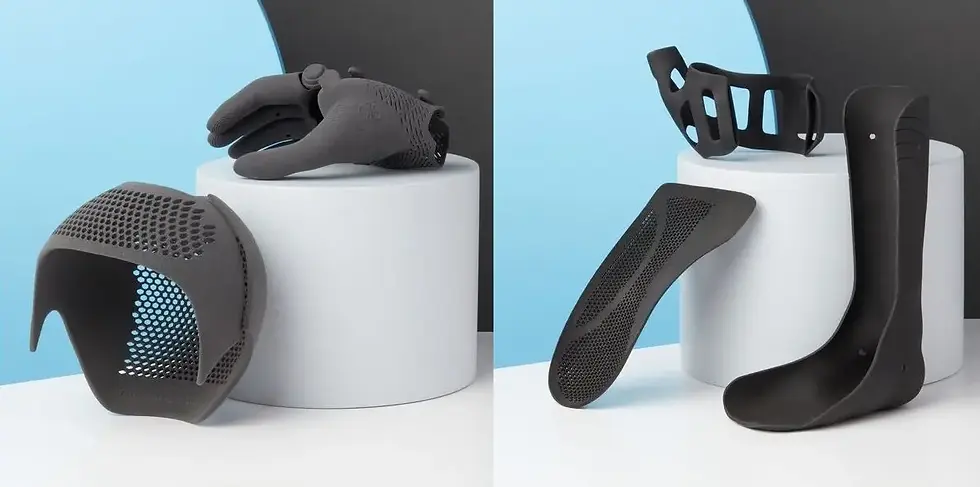SLS 3D Printing Used in Orthotics
- Locanam 3D Printing
- Jul 4, 2024
- 3 min read
It's widely known that prototyping was among the initial uses for SLS 3D printing and remained highly favored. As technology, materials, and post-processing techniques meet manufacturing standards, many professionals increasingly shift from traditional methods to 3D printing. This move allows them to produce final parts directly, beyond prototyping.

The orthotics industry, which specializes in creating Orthotics (devices applied externally to influence the structure and function of the neuromuscular and skeletal systems), is an example of the 3D printing revolution. This market has been steadily growing over the years, alongside advancements in 3D printing in the medical field and prosthetics overall. A recent report predicts that the market will be worth around $6 billion by 2028. This growth is driven by the digitization of the process, which allows for the rapid production of orthotics tailored to a patient's specific needs. These devices not only fit perfectly but are also thin, durable, lightweight, and consistently repeatable.
Traditional Orthotics vs. SLS 3D Printed Orthotics
Orthotic devices can be produced using various methods based on the final application of the part. Traditional manufacturing techniques such as plaster casting, impression foam casting, conventional machining, thermoforming, and wax casting may be employed to create orthoses.
The SLS 3D Printed Orthotics model is customized and shaped to perfectly match the patient's needs. This process may require several appointments to make necessary adjustments. These sessions can last several hours and might span multiple weeks based on the treatment plan. Additionally, the orthotic undergoes post-processing and finishing to get it ready for use.
During this manual process, potential errors can accumulate at each step of the workflow. Mistakes in casts, inaccurate measurements, and design flaws can lengthen an already time-consuming procedure, leading to increased manual labor, longer production times, and more patient appointments. Additionally, this manual workflow demands specialized labor in an environment filled with dust and chemical fumes. Overall, completing a single customization can take three to six weeks.
Benefits of SLS 3D Printing for Orthotics
SLS 3D-printed orthotics are both cost-effective and efficient, making personalized solutions available to a broader range of patients and beneficial for orthopedic producers. As professionals adopt new processes, using 3D printing for orthotics has consistently proven to boost efficiency and lower expenses.

Cost Saving
Reduce production, labor, materials, storage, and shipping expenses by modern and smooth your operations using SLS 3D printing. Traditional methods often involve extra materials for making impressions and molds, which also require storage space. SLS 3D printing eliminates the necessity for these additional materials. Moreover, the post-production process of SLS 3D-printed orthotics reduces labor, enhancing overall efficiency.
Sustainability
Much less raw material is needed to create the final product because there's no need to make a physical model or replica. Selective laser sintering (SLS) 3D printing, which is employed in making various types of orthotics, allows the reuse of powder in subsequent builds, drastically cutting down on waste. Unlike conventional production methods that involve disposing of models and plastics, 3D printing reduces waste and lessens the reliance on harmful chemicals.
Improved Shipping
Digitization makes managing logistics easier. With a 3D scan, you can capture images from any location and send them electronically for digital modeling and design. Once the design is complete, digital files can be sent directly to the printer, whether it's nearby or far away.
Time Savings
Digital processes help Orthotics and patients save time. Streamlined workflows enable Orthotics and their teams to spend less time making models and handling post-processing, freeing them up for more important duties. Patients benefit from fewer fittings and shorter appointment times required for taking impressions and measurements.
Simple Workflow
Digital workflows are more efficient and streamlined, reducing the need for extensive manual processes such as multiple patient visits for fittings. Additionally, batch printing allows for the simultaneous printing of several orthoses, depending on their size and type.
Comments